Guide H-622
Reviewed by Esteban Herrera, Extension Horticulturist
College of Agriculture, Consumer and Environmental Sciences New Mexico State University. (Print Friendly PDF)
Most people have never seen a pecan flower. The absence of petals causes these small, but important, organs to go unnoticed. Abundance of catkins does not mean that female flowers (pistillate flowers or small nutlets) will be produced.
Female flowers, existing as spikes on the side of the shoot near its apex, have the potential of developing into nuts the grower will harvest 7 months later provided they are pollinated, fertilized, and properly cultivated.
Knowledge of the pecan flowering habit is essential as the grower attempts to find pecan nut casebearer eggs or estimate yield. Response to various kinds of pruning can be understood only if the flowering habit is known.
1. Often there are two, three, or more buds at each node. The bud nearest the terminal end of the shoot usually is the most prominent and is known as the primary bud (A). The others are reserve buds and may not grow unless the primary bud or shoot resulting from the primary bud is destroyed by freeze, insects or other enemies. Thus, the pecan has a second chance to flower.1
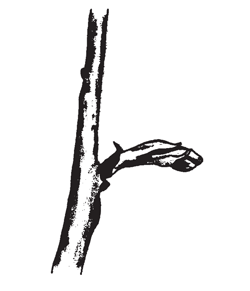
2. The bud scale that has covered the undeveloped shoot and anthers since the entire bud was laid down last summer either breaks near the base and is carried up as the shoot elongates or is split open allowing the shoot to push through.
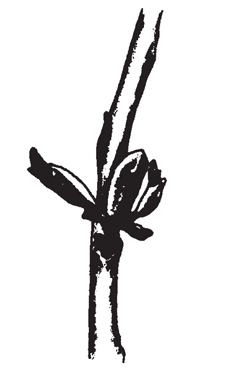
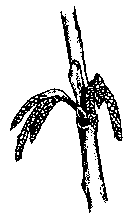
4. As secondary scales split, the two three-stalked catkins on either side of the elongating vegetative shoot are apparent. The catkins were differentiated almost a year earlier-soon after the buds, of which they are a part, were laid down.
5. Catkins and shoots elongate. The male flowers (staminate flowers) on the catkins are now far enough apart to be seen. The number of flowers may range up to 115 per stalk. Each flower consists of a leafy bract with three to five anthers (A). Each anther may contain 2,000 pollen grains. There are four anthers per flower, 110 flowers per stalk, three stalks per catkin, and two catkins per primary bud.2
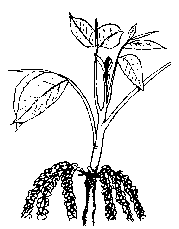
6. The shoot continues to grow several more inches after the catkins have fully elongated. The shoot usually produce eight to ten compound leaves on each shoot before female (pistillate) flowers are produced. Each compound leaf is usually composed of 13 to 17 leaflets.
7. The shoot may or may not produce female flowers. If sufficient carbohydrates are present, the female flowers will form (differentiate from vegetative tissue) in the very early stages of growth in the spring, while still under the primary bud scale. Four to 6 weeks later the female flowers become visible (A).

8. The flowers form a typical spike with the growing point remaining vegetative until it has grown sufficiently to produce perhaps several female flowers (A). The number is determined by the variety and by the vigor of growth of the shoot. The individual female flower measures 5.5 to 8 mm in length, half of which is enclosed in a light green pubescent (hairy) calyx. The calyx is marked by four ridges, giving it a four-sided appearance and dividing it into four sections, each of which is terminated by a tapering bract 3 to 5 mm long. These bracts may be erect around the stigma, as in Mahan (B), that constitutes the remainder of the female flower or spread out, as in Success (C).
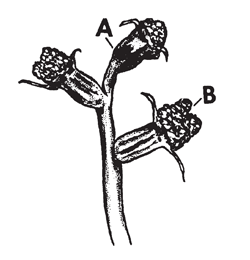
9. Ultimately the vegetative growing point abscises (A) producing a scar at the terminus of the inflorescence, except that in some rare cases the shoot continues growth producing a normal shoot with pecans borne laterally and normal leaves occurring both below and above the nuts. Abscission of the growing point after development of the female flowers is probably caused by depletion of carbohydrates. Do not confuse this continued growth of the shoot with the late season growth of current season developed lateral buds, commonly developing on the shoot below the nuts in response to high soil nitrogen and high soil moisture content. The stigmas may become receptive after pollen is shed (protandrous dichogamy) or before pollen shedding (protogynous dichogamy). Most varieties do not shed pollen at the time of pollen receptivity (complete dichogamy). For example, some protandrous varieties are Western, Barton, Caddo, Desirable, Moore, Texas Prolific, and San Saba Improved.
Protogynous varieties are Mahan, Apache, Comanche, Wichita, Mohawk, Shawnee, Sioux, and Choctaw. In some years there may be some overlap between pollen shedding and stigma receptivity (incomplete dichogamy) but a grower should select varieties as though they will not overlap (complete dichogamy), for many times they do not. If natives, which have a combination of both types of dichogamy, are not present, care should be taken to insure that both protandrous and protogynous types are planted in the same orchard. A viscous fluid covers the uneven surface of the stigma (B) which retains pollen grains carried by wind to the stigma during its receptivity. This process is known as pollination.
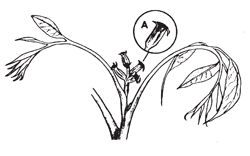
10. Shriveled, hard, brown stigmas (A) indicate that receptivity has passed. Fertilization (union of male gamete and egg) will take place 5 to 7 weeks after pollination.
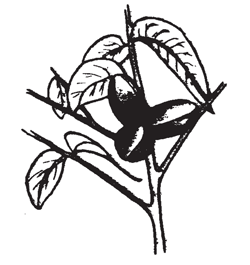
11. The fertilized female flowers rapidly develop into the fruit of the pecan known as a nut. The first half of its development is utilized in developing size and the last half, in filling the shell (ovary wall) with two cotyledons known as a kernel.
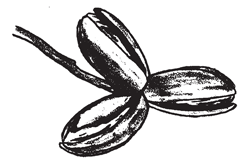
12. The calyx, which was the outer portion of the female flower, continues to grow in proportion to the developing nut so that it covers the mature nut. At this latter stage it is known as the shuck and split apart upon reaching maturity, allowing the nut to break free during harvesting. If the shuck does not separate freely from the shell problems are indicated. The shuckworm may tunnel through the shuck, causing a malfunction, which results in lack of nut filling and "gluing" of shuck to the shell. A freeze may kill the tissue of the shuck before it has time to separate naturally. The shuck of round varieties, such as the Burkett, may open as much as an oblong variety, such as Western, but the inward curvature of the shucks of the round variety do not afford enough space for the nut to drop through the opening as do the more oblong varieties. Thus, the water-saturated, fibrous shucks serve as media for sprouting of the nuts. This factor explains why round varieties, such as Burkett may frequently sprout in the shuck.
1Secondary buds may produce female, but not male, flowers
when regrowth occurs following loss of primary shoots.
2Each primary bud could produce well over 5 million pollen grains. This number is sufficient to pollinate enough flowers to produce 100,000 pounds of good average pecans of standard variety. A single tree could produce enough pollen to produce the nation's entire annual crop if the pollen grains from this tree were properly distributed. Obviously, pollen distribution, although wind-blown, is never ideal. Chance pollination may occur with pollen from as far away as 2 to 3 miles, but the grower should not depend upon pollination from more than 400 feet away. Wind direction is an important factor.
Reprinted from Texas A&M University publication L-882 by J. Benton Storey, associate professor of pomology, Department of Soil and Crop Sciences.
Reproduced from THE PECAN QUARTERLY
To find more resources for your business, home, or family, visit the College of Agricultural, Consumer and Environmental Sciences on the World Wide Web at pubs.nmsu.edu
Contents of publications may be freely reproduced for educational purposes. All other rights reserved. For permission to use publications for other purposes, contact pubs@nmsu.edu or the authors listed on the publication.
New Mexico State University is an equal opportunity/affirmative action employer and educator. NMSU and the U.S. Department of Agriculture cooperating.
April 1999,Las Cruces, NM


